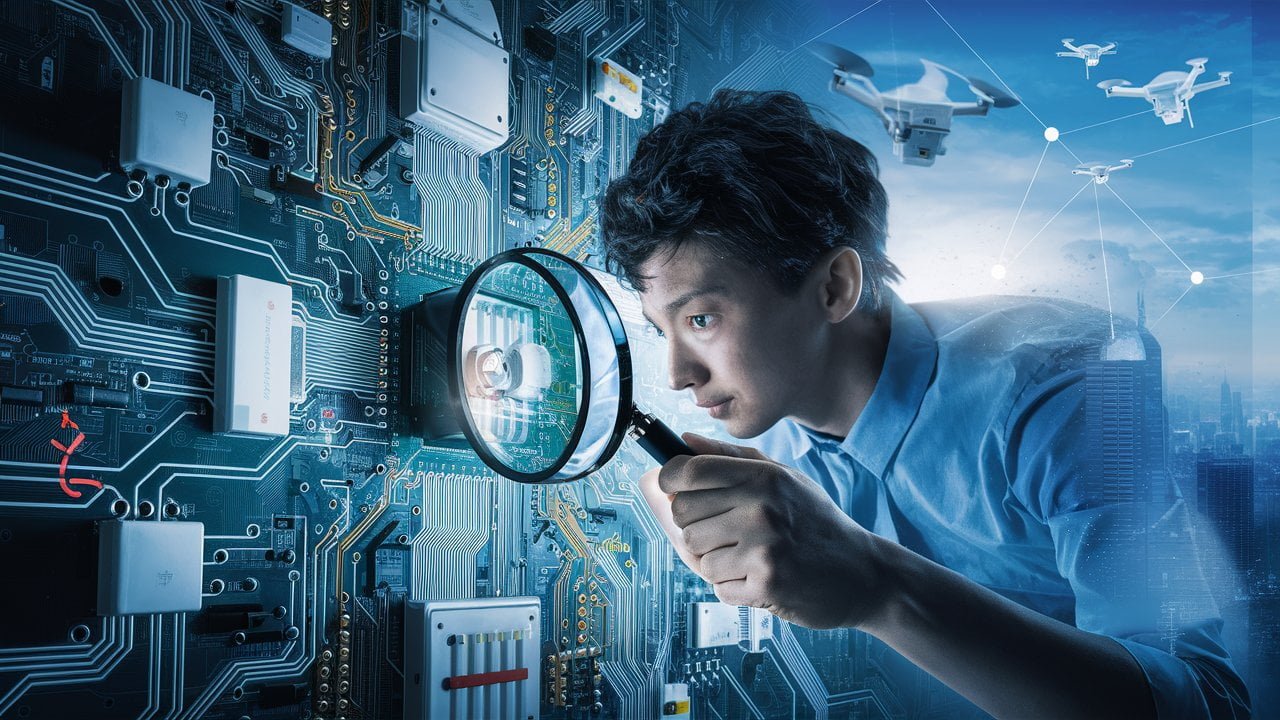In an era where connectivity reigns supreme, the term “Internet of Things” (IoT) has become a ubiquitous buzzword in technological discourse. Defined as a network of interconnected devices that communicate and share data over the internet, IoT embodies a paradigm shift in how we interact with technology.
From smart thermostats optimizing energy consumption to wearable health trackers monitoring vital signs, IoT permeates diverse industries with its transformative capabilities.
The enigmatic realm of IoT is not confined to mere gadgets; it is orchestrating a profound metamorphosis across sectors previously untouched by digitization. In healthcare, IoT empowers remote patient monitoring, revolutionizing precision medicine through real-time data insights.
Transitioning into smart homes, IoT engenders automation and heightened security measures for unparalleled living convenience. Meanwhile, agriculture witnesses a renaissance as IoT spearheads precise farming practices and granular crop management techniques.
With each sector embracing the boundless potential of interconnected systems under the IoT umbrella, a new technological dawn emerges, heralding efficiency and innovation like never before. Join us on an enlightening journey as we unravel the mysteries of IoT’s impact on modern technology landscapes.
Understanding IoT Technology.
The Internet of Things (IoT) is a network of interconnected devices embedded with sensors, software, and other technologies to exchange data with other connected devices or systems over the internet without human intervention.
This groundbreaking concept enables everyday objects to collect and share information, creating a smart environment that enhances efficiency and convenience in various domains.
For instance, imagine a smart thermostat in a home adjusting the temperature based on occupancy patterns or weather forecasts automatically; this is a simple yet powerful illustration of IoT in action.
At the core of IoT technology are sensors that gather data from the surrounding environment or the device itself. These sensors can monitor variables like temperature, humidity, motion, or light levels. Connectivity plays a crucial role in IoT systems by facilitating communication between devices and sending collected data to centralized servers for processing.
Whether through Wi-Fi, Bluetooth, or cellular networks, these connections enable seamless data transmission across the IoT ecosystem.
Furthermore, data processing mechanisms analyze the incoming information to derive meaningful insights or trigger actions based on predefined algorithms. This processing step is vital for making real-time decisions within IoT applications effectively.
In practical terms, consider a smart irrigation system deployed in agriculture where soil moisture sensors collect data about the crops’ hydration levels. The connectivity aspect allows this information to be transmitted wirelessly to a server for analysis.
Subsequently, based on predefined algorithms and weather predictions, automated actions such as activating sprinklers can ensure optimal crop hydration without human intervention.
Through this cohesive functioning of sensors, connectivity protocols, and data processing elements, IoT technology revolutionizes traditional processes by enabling smart decision-making and automation across diverse sectors with immense potential for innovation and optimization.
Applications of IoT in Different Sectors.
In the realm of healthcare, IoT plays a pivotal role in revolutionizing patient care through remote monitoring solutions. By integrating IoT devices such as wearable sensors and connected medical equipment, healthcare providers can remotely track vital signs, medication adherence, and overall patient health status in real-time.
This seamless monitoring not only enhances the quality of care but also enables timely interventions, reducing hospital readmissions and fostering greater independence for patients with chronic conditions.
For instance, smart insulin pumps equipped with IoT capabilities can continuously monitor blood glucose levels and deliver precise insulin doses, empowering diabetic individuals to manage their condition effectively while receiving remote assistance from healthcare professionals.
Transitioning to smart homes, IoT technologies are reshaping living spaces by introducing automation and heightened security measures.
From smart thermostats that adjust temperatures based on residents’ preferences to connected doorbell cameras that offer real-time surveillance capabilities, IoT-enabled smart home devices provide convenience and peace of mind.
Through integrated systems controlled via smartphones or virtual assistants, homeowners can remotely manage lighting, climate control, and security settings even when away from home.
For example, automated door locks combined with motion sensors enhance home security by sending alerts to homeowners’ devices in case of unauthorized access attempts, reinforcing overall safety measures within residential environments.
In agriculture, IoT’s impact is evident in the realm of precision farming practices aimed at optimizing crop management processes for increased yields and resource efficiency.
By deploying sensor networks across fields to monitor soil moisture levels, temperature variations, and nutrient concentrations in real-time, farmers can make data-driven decisions regarding irrigation scheduling and fertilizer application.
This targeted approach minimizes water wastage while maximizing crop productivity. One notable application includes drones equipped with multispectral cameras that capture high-resolution images used for detecting plant diseases early on or assessing crop health metrics efficiently.
Such advancements showcase how IoT integration fosters sustainable agricultural practices by minimizing environmental impacts through informed decision-making based on predictive analytics derived from interconnected data sources.
These examples illustrate just a fraction of the possibilities that arise when IoT technology is harnessed across diverse sectors such as healthcare, smart homes, and agriculture.
As industries continue to embrace these innovative solutions driven by interconnected devices and intelligent data processing capabilities, the transformative power of IoT is poised to redefine operational efficiencies while enhancing user experiences extensively.
Security Challenges in IoT.
In the dynamic landscape of IoT, security concerns loom large as interconnected devices create a web vulnerable to cyber threats. One of the primary challenges is safeguarding against data breaches where sensitive information collected by IoT sensors can be intercepted or manipulated.
For instance, in healthcare, the transmission of patient data from wearables to medical databases faces risks of unauthorized access if encryption protocols are not robustly implemented.
Such breaches could compromise patient privacy and even alter vital health records, underscoring the critical need for stringent cybersecurity measures in IoT systems.
Unauthorized access emerges as another prominent security risk in the realm of IoT. Imagine a scenario in smart home automation where hackers gain control over door locks or surveillance cameras due to vulnerabilities in the connected network. This intrusion not only violates personal privacy but also raises safety concerns for inhabitants.
These instances emphasize the importance of continuous monitoring and timely patching of security loopholes to prevent unauthorized parties from exploiting weaknesses within interconnected IoT devices.
Moreover, with the proliferation of interconnected devices across diverse sectors like agriculture and manufacturing, ensuring comprehensive security measures becomes increasingly complex. Vulnerabilities present in one device can potentially cascade through an entire network, amplifying the scale of potential cyber threats.
Proactive strategies such as conducting regular security assessments, implementing robust authentication mechanisms, and employing encrypted communication channels play pivotal roles in mitigating these risks and fortifying the resilience of IoT ecosystems against malicious actors looking to exploit vulnerabilities for various nefarious purposes.
Future Trends in IoT Technology.
Looking ahead, the future of IoT technology holds exciting prospects with the rise of edge computing. This innovative approach involves processing data nearer to its source, which significantly reduces latency and enhances real-time decision-making capabilities.
For instance, in smart factories, edge computing enables predictive maintenance by analyzing sensor data on-site, thereby preventing costly breakdowns before they occur. This trend not only improves operational efficiency but also opens doors for new applications demanding instant responses.
Moreover, the convergence of Artificial Intelligence (AI) and IoT is set to revolutionize various industries by enabling more advanced automation and intelligent decision-making processes.
For example, in healthcare, AI algorithms integrated with IoT devices can analyze patient health data in real-time to provide personalized treatment recommendations or alert healthcare providers to critical conditions promptly.
This synergy between AI’s cognitive abilities and IoT’s connectivity paves the way for autonomous systems that adapt and respond intelligently to changing environments.
As we move towards a more interconnected world driven by IoT technologies, these emerging trends emphasize the importance of optimizing data processing capabilities at the edge while harnessing AI for enhanced insights and automation.
The fusion of these technologies not only streamlines operations but also empowers businesses across sectors to make informed decisions faster than ever before. By embracing these future trends in IoT technology, organizations can stay ahead of the curve in an increasingly dynamic digital landscape where innovation is key to success.
Ethical Considerations in the Age of IoT.
In the rapidly advancing landscape of IoT technology, ethical considerations stand as a crucial focal point. One of the primary concerns revolves around privacy implications stemming from the continuous data collection initiated by IoT devices.
As these interconnected gadgets gather immense volumes of personal and operational data, questions on who should access, control, and potentially monetize this information come to the forefront.
This raises significant alarms regarding user privacy and data protection in an era where everything from smart homes to wearable devices contributes to a virtual trail of personal details.
Another critical dimension in the ethical discourse surrounding IoT is the intricate web of dilemmas concerning data ownership and consent. With intricately networked ecosystems forming through interconnected devices exchanging data prolifically, delineating clear lines on who actually owns this data becomes complex.
Moreover, obtaining meaningful consent from users for collecting and manipulating their information amid these labyrinthine digital networks poses a formidable issue.
As individuals engage with numerous IoT devices daily, understanding what rights they retain over their data amidst pervasive connectivity underscores the profound ethical challenges faced by both users and developers alike.
To shed light on these ethical quandaries tied to IoT systems, envision a scenario where a health monitoring device discreetly collects sensitive medical information without explicit user consent or without offering transparent guidelines on how this data will be utilized or safeguarded.
Such instances illuminate the pressing need for robust frameworks that ensure accountability, transparency, and stringent privacy measures within the realm of connected technologies.
Addressing these issues necessitates not only technical safeguards but also a paradigm shift towards establishing ethically sound practices that uphold individual autonomy and data sovereignty in an increasingly hyperconnected world.
Impact of 5G on IoT Advancement.
The advent of 5G technology promises a monumental shift in the landscape of the Internet of Things (IoT). As 5G networks continue to roll out, they pave the way for unprecedented advancements in the realm of interconnected devices.
This evolution is set to propel IoT applications into new realms of possibilities, enabling ultra-reliable, low-latency communication that was previously unattainable with slower network standards.
The exponential increase in connectivity speeds and reduced latency heralded by 5G is poised to revolutionize how IoT devices communicate and interact with each other and their environments.
One significant impact of 5G on IoT advancement lies in its ability to support a broader array of connected applications with enhanced performance metrics. For instance, industries reliant on real-time data processing, such as healthcare or manufacturing, stand to gain immensely from the reduced latency offered by 5G networks.
Imagine a scenario where medical professionals remotely monitor critical patients through IoT-connected wearables; with the lightning-fast response times enabled by 5G, these devices can transmit vital data instantaneously, potentially saving lives in urgent situations.
Furthermore, the faster speeds facilitated by 5G networks not only accelerate data transmission between IoT devices but also open doors for innovative solutions across sectors like transportation and smart cities. Consider autonomous vehicles leveraging real-time data exchange through interconnected sensors linked via high-speed 5G connections.
These vehicles can make split-second decisions based on constantly updated information received from surrounding infrastructure – a feat made possible by the seamless integration of IoT and 5G technologies.
The synergy between these two advancements isn’t merely about speed; it’s about unlocking a future where intelligent systems seamlessly communicate and collaborate in ways once deemed futuristic.
The Role of Data Analytics in Harnessing IoT Data.
In the realm of IoT, data analytics plays a pivotal role in making sense of the copious amounts of information generated by interconnected devices. Big data analytics acts as the cornerstone for extracting valuable insights from the vast pool of data collected through IoT sensors and devices.
By utilizing advanced algorithms and machine learning techniques, businesses can gain actionable intelligence that empowers them to make informed decisions swiftly and accurately.
Through sophisticated data processing, companies can uncover patterns, trends, and correlations within IoT-generated data that might otherwise remain hidden.
One excellent illustration of the power of predictive analytics driven by IoT data is in predictive maintenance. Companies across industries are leveraging IoT sensors on machinery to collect real-time performance data.
By analyzing this data using predictive analytics models, organizations can predict when equipment is likely to fail before it does so. This proactive approach not only minimizes downtime but also reduces maintenance costs significantly.
Such predictive capabilities demonstrate how harnessing IoT-generated data through analytics not only optimizes operational efficiency but also enhances overall productivity.
Furthermore, in the retail sector, predictive analytics based on IoT data contributes to personalized customer experiences and effective inventory management. Retailers analyze consumer behavior patterns captured through connected devices like beacons or smart shelves to anticipate customer preferences accurately.
This insight enables businesses to tailor marketing campaigns, optimize product placement strategies, and ensure efficient inventory levels. Thus, by amalgamating IoT-generated data with robust analytics tools, companies can drive growth, improve customer satisfaction levels, and stay ahead in today’s highly competitive market landscape.
Sustainability Aspects in Implementing IoT Solutions.
In the realm of Internet of Things (IoT), sustainability plays a pivotal role in shaping the future of connected technologies. By integrating sustainable practices into IoT solutions, not only can organizations reduce their environmental footprint but also enhance operational efficiency.
One prominent example lies within smart cities, where IoT serves as a cornerstone for energy-efficient approaches. Through interconnected devices and sensors, smart grids can optimize energy consumption, monitor emissions, and manage waste more effectively.
Consequently, this integration contributes to the overall sustainability goals of cities by curbing resource wastage and minimizing pollution levels.
Furthermore, the implementation of IoT solutions in various sectors underscores the importance of sustainability considerations. For instance, in agriculture, precision farming techniques made possible through IoT technologies enable farmers to utilize resources more efficiently.
By employing sensors to monitor soil moisture levels or crop conditions accurately, farmers can optimize irrigation schedules and use fertilizers judiciously, thereby promoting sustainable agricultural practices.
This not only leads to improved crop yields but also reduces water usage and chemical runoff, safeguarding both environmental health and long-term productivity.
Overall, by embracing sustainability principles within the framework of IoT deployments, businesses and communities can achieve a harmonious balance between technological advancement and environmental conservation.
As IoT continues to evolve and permeate diverse industries, prioritizing sustainability will be integral to maximizing its benefits while minimizing adverse ecological impacts.
Embracing energy-efficient strategies enabled by IoT not only fosters innovation but also paves the way towards a greener and more resilient future powered by connected technologies.
Conclusion: Shaping the Future Through Connected Technologies.
As we navigate the ever-evolving landscape of technology, the Internet of Things (IoT) emerges as a cornerstone in transforming industries and revolutionizing daily processes.
The interconnected web of devices, sensors, and data analytics presents boundless opportunities for innovation across sectors ranging from healthcare to agriculture. Advancements in IoT technology propel us towards a future where efficiency, precision, and sustainability converge to reshape our environments.
In this interconnected realm, the fusion of artificial intelligence with IoT heralds a new era of intelligent decision-making while also raising critical ethical considerations regarding data privacy and ownership.
As we stand at the intersection of IoT and 5G networks, poised to unlock unprecedented connectivity speeds and reduced latency, the potential for IoT applications continues to expand exponentially.
By embracing sustainable practices within IoT solutions and harnessing the power of big data analytics for actionable insights, we pave the way for a future where connected technologies drive progress and enable us to navigate complexities with ease.
Together, we shape a tomorrow that is not just connected but consciously designed for a smarter world fueled by innovation and collaboration in this age of IoT.




